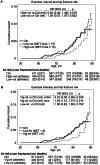Longitudinal Associations of High-Volume and Vigorous-Intensity Exercise With Hip Fracture Risk in Men
- PMID: 35699286
- PMCID: PMC9544739
- DOI: 10.1002/jbmr.4624
Longitudinal Associations of High-Volume and Vigorous-Intensity Exercise With Hip Fracture Risk in Men
Abstract
Maintenance of vigorous exercise habits from young to old age is considered protective against hip fractures, but data on fracture risk in lifelong vigorous exercisers are lacking. This longitudinal cohort study examined the hazard of hip fractures in 1844 male former athletes and 1216 population controls and in relation to exercise volume and intensity in later years. Incident hip fractures after age 50 years were identified from hospital discharge register from 1972 to 2015. Exercise and covariate information was obtained from questionnaires administered in 1985, 1995, 2001, and 2008. Analyses were conducted using extended proportional hazards regression model for time-dependent exposures and effects. During the mean ± SD follow-up of 21.6 ± 10.3 years, 62 (3.4%) athletes and 38 (3.1%) controls sustained a hip fracture. Adjusted hazard ratio (HR) indicated no statistically significant difference between athletes and controls (0.84; 95% confidence interval [CI], 0.55-1.29). In subgroup analyses, adjusted HRs for athletes with recent high (≥15 metabolic equivalent hours [MET-h]/week) and low (<15 MET-h/week) exercise volume were 0.83 (95% CI, 0.46-1.48) and 1.04 (95% CI, 0.57-1.87), respectively, compared with controls. The adjusted HR was not statistically significant between athletes with low-intensity exercise (<6 METs) and controls (1.08; 95% CI, 0.62-1.85). Athletes engaging in vigorous-intensity exercise (≥6 METs at least 75 minutes/week) had initially 77% lower hazard rate (adjusted HR 0.23; 95% CI, 0.06-0.86) than controls. However, the HR was time-dependent (adjusted HR 1.04; 95% CI, 1.01-1.07); by age 75 years the HRs for the athletes with vigorous-intensity exercise reached the level of the controls, but after 85 years the HRs for these athletes increased approximately 1.3-fold annually relative to the controls. In conclusion, these data suggest that continuation of vigorous-intensity exercise is associated with lower HR of hip fracture up to old age. © 2022 The Authors. Journal of Bone and Mineral Research published by Wiley Periodicals LLC on behalf of American Society for Bone and Mineral Research (ASBMR).
Keywords: AGING; EXERCISE; FRACTURE PREVENTION; LONGITUDINAL STUDIES; OSTEOPOROSIS.
© 2022 The Authors. Journal of Bone and Mineral Research published by Wiley Periodicals LLC on behalf of American Society for Bone and Mineral Research (ASBMR).
Conflict of interest statement
All authors state that they have no conflicts of interest.
Figures


Similar articles
-
Telomere Length and Risk of Incident Fracture and Arthroplasty: Findings From UK Biobank.J Bone Miner Res. 2022 Oct;37(10):1997-2004. doi: 10.1002/jbmr.4664. Epub 2022 Sep 13. J Bone Miner Res. 2022. PMID: 35880304 Free PMC article.
-
Leisure-Time Physical Activity and Risk of Fracture: A Cohort Study of 66,940 Men and Women.J Bone Miner Res. 2017 Aug;32(8):1599-1606. doi: 10.1002/jbmr.3161. Epub 2017 Jun 13. J Bone Miner Res. 2017. PMID: 28460152 Clinical Trial.
-
Impact of Stroke History on the Risk of Recurrent Hip Fracture or Major Osteoporotic Fractures among Patients with Incident Hip Fracture: A Nationwide Cohort Study.J Bone Miner Res. 2023 Feb;38(2):278-287. doi: 10.1002/jbmr.4760. Epub 2022 Dec 30. J Bone Miner Res. 2023. PMID: 36533810 Free PMC article.
-
Association of Physical Activity and Fracture Risk Among Postmenopausal Women.JAMA Netw Open. 2019 Oct 2;2(10):e1914084. doi: 10.1001/jamanetworkopen.2019.14084. JAMA Netw Open. 2019. PMID: 31651972 Free PMC article.
-
Fracture prevention by screening for high fracture risk: a systematic review and meta-analysis.Osteoporos Int. 2020 Feb;31(2):251-257. doi: 10.1007/s00198-019-05226-w. Epub 2019 Dec 14. Osteoporos Int. 2020. PMID: 31838551 Free PMC article.
Cited by
-
Brief, Low-impact, High-intensity Osteogenic Loading in Postmenopausal Osteoporosis: A Quasi-experimental Case-series Study.J Clin Endocrinol Metab. 2025 Aug 7;110(9):e2878-e2887. doi: 10.1210/clinem/dgaf077. J Clin Endocrinol Metab. 2025. PMID: 39918073 Free PMC article.
References
-
- Moayyeri A, Besson H, Luben RN, Wareham NJ, Khaw KT. The association between physical activity in different domains of life and risk of osteoporotic fractures. Bone. 2010;47(3):693‐700. - PubMed
-
- Stattin K, Michaelsson K, Larsson SC, Wolk A, Byberg L. Leisure‐time physical activity and risk of fracture: a cohort study of 66,940 men and women. J Bone Miner Res. 2017;32(8):1599‐1606. - PubMed
-
- Moayyeri A. The association between physical activity and osteoporotic fractures: a review of the evidence and implications for future research. Ann Epidemiol. 2008;18(11):827‐835. - PubMed
-
- Morseth B, Ahmed LA, Bjornerem A, et al. Leisure time physical activity and risk of non‐vertebral fracture in men and women aged 55 years and older: the Tromso study. Eur J Epidemiol. 2012;27(6):463‐471. - PubMed
-
- Jaglal SB, Kreiger N, Darlington G. Past and recent physical activity and risk of hip fracture. Am J Epidemiol. 1993;138(2):107‐118. - PubMed
Publication types
MeSH terms
Grants and funding
LinkOut - more resources
Full Text Sources
Medical
Miscellaneous

